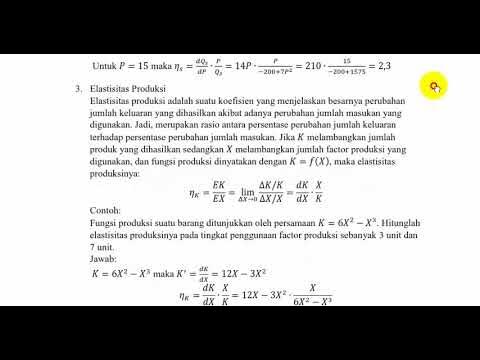elastisitas permintaan dan penawaran Autosaved
Summary
TLDRThis transcript provides an in-depth exploration of elasticity in economics, covering both demand and supply elasticity. It defines key concepts such as price elasticity, income elasticity, and cross-price elasticity, and illustrates their calculations with practical examples. The discussion also highlights the significance of elasticity in business and government policy-making, as well as the factors influencing demand and supply elasticity. Various types of elasticity, including perfectly elastic and perfectly inelastic demand and supply, are also examined, making this a comprehensive guide for understanding how changes in price and income affect market dynamics.
Takeaways
- 😀 Elasticity measures how responsive the quantity demanded or supplied is to changes in price.
- 📊 Price Elasticity of Demand (PED) shows the percentage change in quantity demanded due to a percentage change in price.
- 💰 Income Elasticity of Demand (YED) indicates how demand changes as consumer income changes, impacting luxury and necessity goods differently.
- 🔄 Cross-Price Elasticity of Demand (XED) assesses how the demand for one good is affected by the price change of another good.
- 📈 Price Elasticity of Supply (PES) reflects the responsiveness of quantity supplied to price changes.
- 🛒 Perfectly inelastic demand means quantity demanded remains constant regardless of price changes (elasticity = 0).
- 🏷️ Perfectly elastic demand indicates consumers will buy infinite quantities at a given price (elasticity = ∞).
- 📏 Unitary elasticity means the percentage change in price results in an equal percentage change in quantity demanded (elasticity = 1).
- 📉 Inelastic demand occurs when the quantity demanded changes less than the price change (elasticity between 0 and 1).
- 📈 Elastic demand signifies that quantity demanded changes more than price changes (elasticity > 1).
- 🔍 Factors influencing demand elasticity include the availability of substitutes, the proportion of income spent, and the time frame considered.
Q & A
What is elasticity in economics?
-Elasticity in economics measures how responsive the quantity demanded or supplied of a good is to changes in price or other economic factors.
What are the three types of demand elasticity discussed in the transcript?
-The three types of demand elasticity are Price Elasticity of Demand (PED), Income Elasticity of Demand (YED), and Cross-Price Elasticity of Demand (XED).
How is Price Elasticity of Demand (PED) calculated?
-PED is calculated using the formula: PED = (Percentage Change in Quantity Demanded) / (Percentage Change in Price).
What does a PED value greater than 1 indicate?
-A PED value greater than 1 indicates that the demand is elastic, meaning quantity demanded changes significantly in response to price changes.
What is the significance of Income Elasticity of Demand (YED)?
-YED indicates how the quantity demanded of a good changes in response to changes in consumer income, helping to categorize goods as normal or inferior.
What does a positive Cross-Price Elasticity of Demand (XED) value signify?
-A positive XED value signifies that the goods are substitutes; as the price of one good increases, the demand for the other good also increases.
What factors influence the elasticity of demand?
-Factors influencing demand elasticity include the availability of substitutes, the proportion of income spent on the good, and the time frame for consumer adjustment.
How is Price Elasticity of Supply (PES) defined?
-PES measures how the quantity supplied of a good responds to changes in price, calculated similarly to demand elasticity.
What does an elastic supply mean in the context of PES?
-An elastic supply means that the quantity supplied changes significantly with price changes, indicated by a PES value greater than 1.
What are some practical applications of elasticity analysis for businesses?
-Elasticity analysis helps businesses set pricing strategies, forecast changes in demand, and assess the potential impact of economic policies.
Outlines

このセクションは有料ユーザー限定です。 アクセスするには、アップグレードをお願いします。
今すぐアップグレードMindmap

このセクションは有料ユーザー限定です。 アクセスするには、アップグレードをお願いします。
今すぐアップグレードKeywords

このセクションは有料ユーザー限定です。 アクセスするには、アップグレードをお願いします。
今すぐアップグレードHighlights

このセクションは有料ユーザー限定です。 アクセスするには、アップグレードをお願いします。
今すぐアップグレードTranscripts

このセクションは有料ユーザー限定です。 アクセスするには、アップグレードをお願いします。
今すぐアップグレード5.0 / 5 (0 votes)






